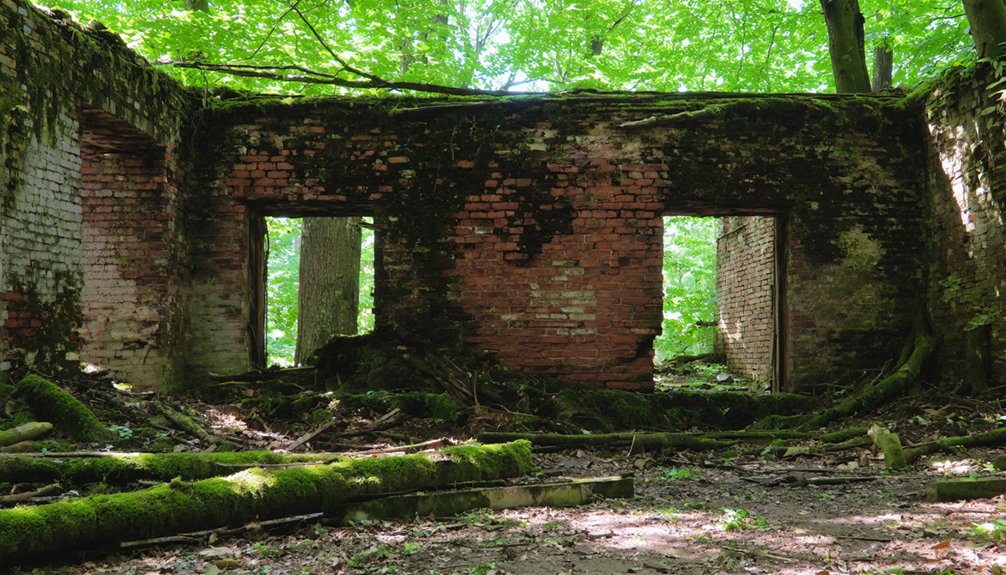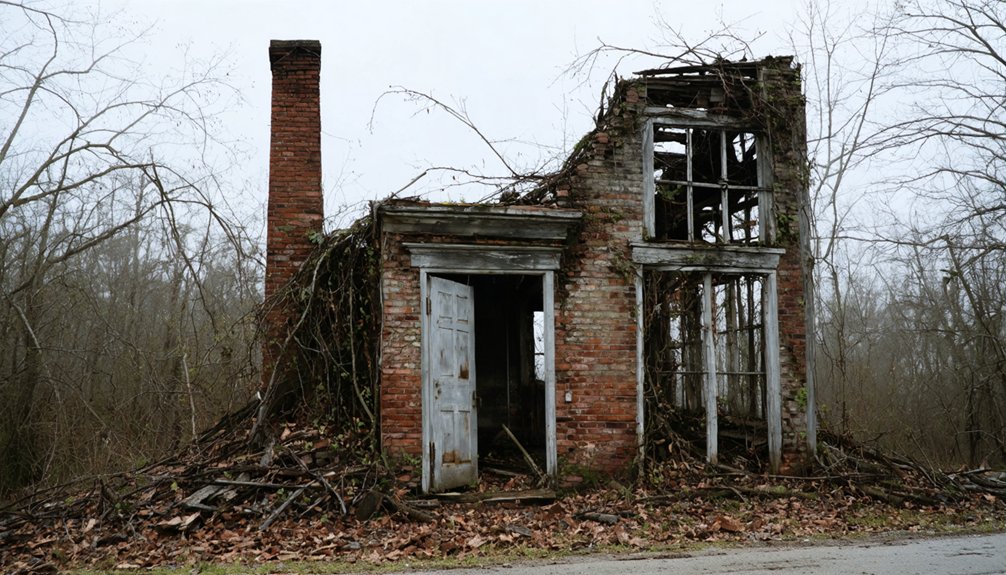You’ll find Tooktocaugee, a former Creek Indian village and ghost town, nestled in Calhoun County, Alabama at coordinates 33°41′35″N 85°41′55″W. This pre-statehood settlement served as a crucial hub within the Creek Confederacy, where Native Americans established complex trade networks and thriving communities along the region’s waterways. Today, the site offers rich archaeological evidence through artifacts, including ceramic fragments and mining relics, while its natural features and cultural significance hold countless untold stories.
Key Takeaways
- Tooktocaugee was established as a Creek Indian village in Calhoun County, Alabama, before becoming abandoned and classified as a ghost town.
- Located at coordinates 33°41′35″N 85°41′55″W, the site contains archaeological evidence of its former life as a Creek settlement.
- The village served as an important trading hub within the Creek Confederacy before its inhabitants were forcibly removed.
- Archaeological investigations have uncovered artifacts including glass, ceramics, and metal relics reflecting the area’s indigenous and industrial past.
- The abandoned settlement sits within Alabama’s Talladega slate belt, featuring diverse mineral resources and natural features that supported early life.
The Lost Creek Village: Origins and Location
Located approximately five miles northwest of Sulligent in Alabama, Lost Creek Village emerged as a settlement in 1814 within Cherokee Territory.
Much like the Creek Indians who inhabited Alabama for thousands of years before European contact, these early inhabitants left their mark on the land through various settlements and cultural sites.
You’ll find this historic community nestled in valley regions near Lost Creek and Village Creek, waterways that drain over 100 square miles of watershed. The area’s name stems from a tragic incident where a boy disappeared along the local creek. This same tragic event would later inspire the original name of Lost Creek for what is now known as Ranburne.
Early settlers didn’t arrive in significant numbers until after the Cherokee removal in the 1830s, drawn by the fertile alluvial soil deposits along the creek beds.
The fertile creek lands remained largely unsettled until the 1830s, when pioneers arrived following the forced exodus of Cherokee inhabitants.
The settlement’s geography placed it between Red Mountain and the Cumberland Plateau‘s ridges, featuring clear running streams and garden-like valleys that proved ideal for farming and cattle raising.
Native American Heritage and Cultural Legacy
Before European settlement transformed the region, the Muscogee (Creek) people maintained a strong presence in what would become Tooktocaugee, establishing complex societies and political structures that dated back generations.
Archaeological evidence indicates that Native Americans developed major trade networks along the Chattahoochee River during the Archaic Period.
Their cultural resilience was evident in the powerful Creek Confederacy, which centered around towns like Tuckabatchee where thousands gathered for important councils.
You’ll find historical narratives of this heritage in the archaeological record and colonial documents, which reveal how the Creek people adapted to European contact while preserving their traditions.
From Fort Toulouse’s trading post to the resistance led by Big Warrior, the area played a significant role in Creek history.
Despite forced removal in the 1830s, which devastated the community during the Trail of Tears, the Creek legacy endures through the Poarch Band’s continued presence in Alabama.
The Cherokee people also faced similar challenges when the Indian Removal Act displaced them from their ancestral lands in the region.
Settlement Patterns and Community Life
Along the rolling hills of northeastern Alabama in Calhoun County, Tooktocaugee emerged as a small, unincorporated community at coordinates 33°41′35″N 85°41′55″W.
Similar to Brady’s early years, where they held services under Magnolia trees, the settlement’s community dynamics centered around extended families, with early inhabitants including both Creek Indian descendants and European-American settlers who arrived in the early 19th century.
Much like the historic Choctaw Corner settlement, the community marked an important boundary between native territories. You’ll find that Tooktocaugee’s settlement evolution followed a pattern common to rural Alabama communities, developing along natural travel routes. Without formal municipal structures, the community likely operated through informal governance and county administration.
Daily life revolved around subsistence activities, with families engaging in farming, hunting, and gathering. While the settlement lacked documented churches, schools, or civic organizations, seasonal gatherings probably strengthened social bonds among residents, reflecting their shared heritage and rural lifestyle.
Environmental Features and Natural Resources
You’ll find Tooktocaugee’s natural environment shaped by its position along Bear Creek, where the waterway supported diverse wildlife and provided essential resources for both Native American and later settlements.
The region’s mixed hardwood and pine forests, combined with fertile loamy soils, created ideal conditions for traditional Creek farming practices and the cultivation of corn, beans, and squash. The area’s historical significance is preserved through its recognition as a former Creek village in Calhoun County.
The humid subtropical climate and reliable water sources sustained the local ecosystem’s rich biodiversity, though seasonal flooding and storms occasionally challenged the community’s resilience.
Local Flora and Fauna
The rich biodiversity of Tooktocaugee reflects Alabama’s humid subtropical climate, with mixed hardwood forests dominating the landscape. Like many of the 4,531 ghost towns across America, the area remains a pristine natural habitat.
You’ll find an abundance of flora species, including towering oaks, hickories, and pines that create a dense canopy overhead. Black-eyed susans and coneflowers dot the understory, while dogwood and honeysuckle vines weave through the forest edges.
The fauna diversity is equally impressive. You can spot white-tailed deer browsing at dawn and dusk, while raccoons emerge at night. In the creek waters, large needle nose gar can be observed swimming among other fish species.
Birds of various species soar above – from graceful raptors to melodious songbirds. In the area’s creeks and streams, bass and catfish swim freely, and during summer evenings, you’ll witness the magical display of fireflies illuminating the forest.
Creek Watershed Features
Hidden beneath the rich canopy of Tooktocaugee’s forests lies an intricate network of creeks and streams, all part of the expansive Coosa River basin that spans over 10,000 square miles.
You’ll find creek dynamics shaped by seasonal rainfall patterns and the region’s distinct geology, where carbonaceous and metamorphic rocks create remarkably clear waters.
The area’s watershed restoration efforts focus on protecting crucial riparian zones that filter runoff and support diverse aquatic life. These waters contribute to the Mobile River basin, which drains approximately 63% of Alabama’s total land area.
While modern dams have altered traditional flow patterns, you can still observe the natural rhythm of these waterways during peak winter and spring flows.
The creek system’s health depends on careful management of urban runoff and agricultural impacts, with local initiatives actively working to preserve these essential water resources for future generations.
Natural Resource Availability
Nestled within Alabama’s Talladega slate belt, Tooktocaugee’s landscape reveals a wealth of natural resources shaped by its distinct geological composition.
You’ll find the terrain dotted with mineral exploration opportunities, from graphite-bearing schists to quartz seams containing tourmaline and tantalite. The area’s elevation of 696 feet supports diverse vegetation, including oak, hickory, and pine forests that once provided sustenance for Creek Indians through strategic resource management.
The region’s pyrite-rich rocks and granite formations offer potential building materials, while the gently rolling hills harbor springs and streams that feed into the broader Coosa River basin.
The moderately fertile soils, derived from weathered schists, sustained indigenous agriculture and medicinal plant harvesting, demonstrating the land’s capacity to support self-sufficient communities.
Historical Significance in Alabama’s Past
You’ll discover that Tooktocaugee’s roots trace back to its establishment as a Creek Indian village in what’s now Calhoun County, Alabama, long before European-American settlement.
The site’s archaeological significance stems from its role as a pre-statehood Native American community hub at coordinates 33°41′35″N 85°41′55″W.
Your exploration of this ghost town opens windows into Alabama’s indigenous past, where Creek settlements like Tooktocaugee formed essential cultural centers before the dramatic shifts of 19th-century settlement patterns.
Native Creek Village Origins
Before its abandonment, Tooktocaugee stood as a prominent Creek Indian village in what’s now Calhoun County, Alabama, serving as an essential component of the larger Creek Confederacy‘s network of tribal towns.
You’ll find that Tooktocaugee’s inhabitants maintained a strong Creek identity through their connection to ancient Mississippian cultures, establishing themselves along the region’s crucial waterways by the 17th century.
The village’s strategic position strengthened historical trade networks throughout east-central Alabama, particularly along the Coosa and Tallapoosa rivers.
As part of the Creek Confederacy’s sophisticated system, Tooktocaugee’s residents engaged in regional commerce, agricultural production, and political alliances.
The settlement exemplified the extensive Indigenous presence that thrived in Alabama before the forced removals of the 1830s devastated Creek communities.
Archaeological Research Opportunities
While many ghost towns across Alabama hold archaeological potential, Tooktocaugee’s site offers exceptional research opportunities for understanding both Creek Indian heritage and early American settlement patterns in Calhoun County.
You’ll find that archaeological techniques could reveal fascinating layers of history through careful excavation of building remains, roadways, and everyday items.
The site’s potential extends beyond physical structures – you’re likely to discover historical artifacts that tell stories of farming practices, local industries, and daily life in rural Alabama.
Environmental factors that influenced the town’s development might be uncovered through soil analysis and structural remnants.
Despite challenges like erosion and limited historical records, you can participate in community-driven research efforts that’ll help preserve Tooktocaugee’s legacy for future generations.
Archaeological Discoveries and Research Potential

Archaeological investigations of Tooktocaugee have yielded a rich assortment of artifacts that paint a vivid picture of life in this former Alabama mining town.
You’ll find antique glass, ceramic fragments, and metal relics scattered along riverbeds and creek banks, with artifact analysis revealing whiskey jugs and mining tags that connect directly to the town’s industrial past.
The site’s natural stratigraphy lets you explore over a century of history through specialized excavation techniques.
You can uncover concentrated deposits in former privy dumps, while metal detecting and mudlarking prove highly effective for artifact recovery.
The combination of paleobotanical remains and man-made objects creates unique research opportunities, allowing you to piece together both the natural and human history of this fascinating ghost town.
Frequently Asked Questions
When Was the Last Recorded Permanent Resident in Tooktocaugee?
You won’t find official records of the last resident in this former Creek settlement, as historical documentation doesn’t specify when the town’s decline led to its complete abandonment.
Are There Any Descendants of Original Tooktocaugee Residents Still Living Nearby?
You won’t find verified descendants near the original site today. While descendant stories and local legends persist in Calhoun County, most Creek families relocated to Oklahoma during the 1830s Trail of Tears.
What Natural Disasters or Events Contributed to Tooktocaugee’s Abandonment?
You’ll find that recurring flood damage near local rivers and creeks likely triggered economic decline, though there aren’t specific documented disasters. The region’s vulnerability to water-related events gradually weakened community stability.
Were Any Significant Artifacts Recovered From the Tooktocaugee Site?
You’ll find significant archaeological findings including intact jaw harps from 1900, coal miner tags, porcelain door knobs, pocket watches, and children’s marbles, revealing the site’s rich mining and community heritage.
Did Any Notable Historical Figures Visit or Document Tooktocaugee?
Despite searching through hundreds of historical records, you won’t find any documented visits by notable figures to Tooktocaugee. No confirmed historical accounts or first-hand documentation of prominent visitors exists.
References
- https://deepsouthurbex.com/2020/01/02/6-south-alabama-ghost-towns/
- https://digitalalabama.com/alabama-ghost-towns/alabama-ghost-towns/9449
- https://en.wikipedia.org/wiki/Tooktocaugee
- https://digitalalabama.com/topic/tooktocaugee-alabama/
- https://freepages.history.rootsweb.com/~gtusa/usa/al.htm
- https://www.youtube.com/watch?v=KljjtI4Az-k
- https://en.wikipedia.org/wiki/List_of_ghost_towns_in_Alabama
- https://birminghamhistoricalsociety.com/wp-content/uploads/2020/02/bhs-village-creek-1985_lr.pdf
- https://encyclopediaofalabama.org/article/ranburne/
- https://www.youtube.com/watch?v=fmK3ZpnqiCI



